CIO’s View: October 2022 - Global political activity is heating up
This month’s piece, we begin with a change tone, as there are quite a few political developments happening around the same time across the world, and all of them have been impacting the market in a very significant way. Beginning with what’s been happening in China, Xi Jinping officially secured a third term as the Chinese Communist party’s head and unveiled a new leadership team packed with loyalists. This leadership team is known as the “Central Committee of the Chinese Communist Party”, or the “Central Committee” in short, while is more officially known as the “Central Committee of the Communist Party of China”. It is a political body that comprises the top leaders of the Chinese Communist Party (CCP). It is currently composed of 205 full members and 171 alternate members. Members are nominally elected once every five years by the National Congress of the Chinese Communist Party. In practice, the selection process is done privately, usually through the consultation of the CCP’s Politburo and its corresponding Standing Committee. The appointments to a new Central Committee omitted some top officials, most prominently Premier Li Keqiang, China’s No.2-ranked leader, who has at times issued signals on economic policy that contradicted Mr. Xi’s Views. The new slate of China’s top leaders, packed with Mr. Xi’s allies, has some economists fearing a further erosion of checks on the power of Xi Jinping. Mr. Xi also replaced more than half of the members of the now 24-member politburo. Many of the appointees worked for Mr. Xi when he was a mid-career provincial party official. No women were appointed to the politburo, breaking with a long convention of appointing a single female member to the group.
In case the readers are wondering about the difference between the Politburo and the Politburo Standing Committee (PSC), the “Politburo of the Chinese Communist Party”, or the “Politburo” in short, is formally known as the “Political Bureau of the Communist Party of China Central Committee” is the decision-making body of the “Chinese Communist Party” (CCP). Up until now that it’s been changed to a 24-member group, it has previously been a group of 25 top officials who oversee the CCP and headed by the general secretary. Unlike politburos of other Communist parties, power within the Chinese politburo is further centralized in the “Politburo Standing Committee” (PSC), officially known as the “Standing Committee of the Political Bureau of the Communist Party of China Central Committee”, which is a group of 7 individuals from among the 24 top officials. The Politburo Standing Comittee (PSC) is a committee consisting of the top leadership of the Chinese Communist Party (CCP). Historically, it has been composed of five to eleven members, but now has seven members. Its officially mandated purpose is to conduct policy discussions and make decisions on major issues when the Politburo, the larger decision-making body, is not in session. The Politburo Standing Committee (PSC) is theoretically responsible to the Politburo, which is in turn responsible to the larger Central Committee. In practice, the Politburo Standing Committee (PSC) is supreme over its parent bodies.
On Sunday, China unveiled the leaders who will sit on the the Politburo Standing Committee (PSC), which is comprised of seven members, with Mr. Xi as the re-elected general secretary of the Chinese Communist Party being a member of the PSC by virtue. Two members of the PSC, Premier Li Keqiang and Wang Yang, were not reappointed despite being young enough for another five-year term. Besides Mr. Xi, anti-corruption top official Zhao Leji and top political theorist Wang Huning remain on the PSC but will be given new portfolios.
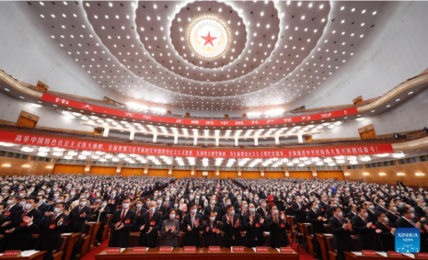
Source: https://english.news.cn/20221022/08058aa98eef4f2094e82b7afae7a70c/c.html
Four of the officials are new appointees.Li Qiang, 63, a former top aide to Mr. Xi, has been the Communist Party secretary of the eastern financial hub of Shanghai since 2017. Cai Qi, 66, has been serving as the Communist Party Chief of Beijing before joining the top leadership. Ding Xuexiang, 60, is Mr. Xi’s chief of staff and a long-time aide. Li Xi, 65, is the new head of the Communist Party’s top disciplinary comission. The outcome of the Communist Party congress signaled the likely continuation of policies that have concerned investors and businesses globally, including the zero-Covid policies and China’s deteriorating ties with the US. It has been speculated by news source and political pundits that China’s current Premier, Li Keqiang, is likely to be succeeded by Li Qiang, the Shanghai party secretary, who’s mentioned above. He was widely seen as a key protege of Mr. Xi, and the promotion showed their relationship was intact with Mr. Li’s handling of the controversial two-month Covid lockdown in Shanghai. Many in the business community see Mr. Li as a relatively liberal party leader who likes discussing commercial ideas. After the big announcement over the weekend, Chinese stock markets didn’t respond so well, with H-Shares falling by -7.3% and A-Shares falling by -2.9% on Monday. However, with H-Shares already down by around -37% and A-Shares already down by around -26% in the YTD (as of 26 October 2022), we think that the current levels have already reflected a lot of bad news, while the markets are quite attractive in terms of valuation metrics.
Chart: H-Shares in the YTD
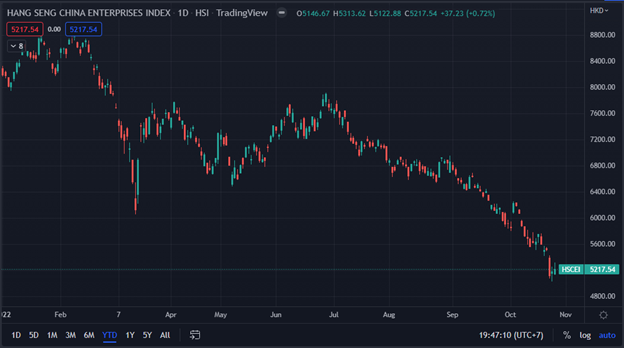
Chart: A-Shares in the YTD
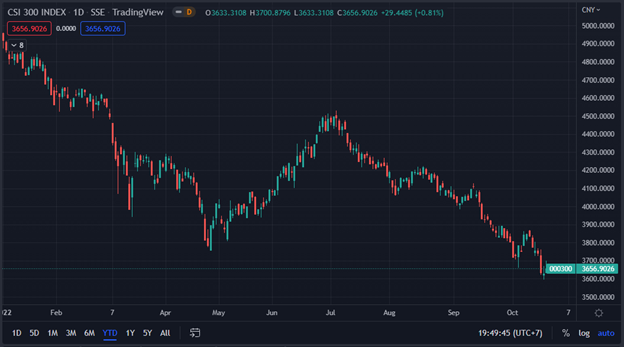
Source: TradingView, as of 26 October 2022
UK’s former Prime Minister Liz Truss had announced her resignation on Thursday, 20 October 2022, making her the shortest-serving prime minister in British history after a tumultuous six weeks that saw her try to push through a risky tax-cut plan, only to be forced by financial markets into a humiliating retreat that caused her political authority to disintegrate. Former Chancellor Rishi Sunak, who warned that Liz Truss’s economic plans for Britain were a fairy tale, won the contest to succeed her as prime minister on Monday, 24 October 2022, taking over the world’s sixth-biggest economy at a time of deep financial and political turbulence. Mr. Sunak’s rise to the top job in Britain marks a historic moment. The grandson of Indian immigrants to Britain, the 42-year-old will be the first person of color and the first Hindu to lead the UK. He will also be the youngest prime minister since Robert Banks Jenkinson, Earl of Liverpool, in 1812. The former hedge-fund manager arrives with a mandate to bring calm to the ruling Conservative Party following a period of unparalleled chaos that will see the country run by three prime ministers in seven weeks—a first for the UK.
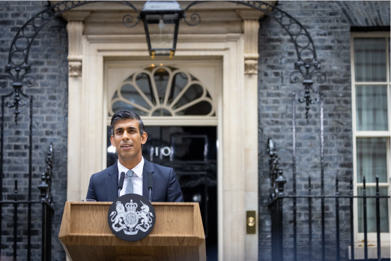
Source: https://brandinside.asia/rishi-sunak-richer-than-united-kingdom-monarch/
On Tuesday, 25 October 2022, Jeremy Hunt was reappointed as chancellor of the exchequer, as new prime minister Rishi Sunak gave him the key job of setting out a plan to put Britain’s public finances back in order. Mr. Sunak and Mr. Hunt will be completing a promised medium-term fiscal plan, which will set out a five-year program to bring the UK’s debt under control. The chancellor has been keen to present the fiscal statement ahead of 3 November 2022, when the Bank of England will hold a crucial meeting to set interest rates. Mr. Hunt hopes that if he can convince the markets and the Office for Budget Responsibility, the UK’s independent fiscal watchdog, that he has a credible plan to control borrowing, the BoE might moderate its expected rate rise. Mr. Hunt remaining in post will reassure investors that Mr. Sunak plans to pursue a similar path of fiscal tightening to that promised by the chancellor in the previous week, when he reversed two-thirds of the £45bn of unfunded tax cuts promised by former prime minister Liz Truss. UK 10-year government bond yield rose as high as 4.6% during intraday of 12 October 2022, due to market participants’ mistrust of the former prime minister Liz Truss’s unfunded tax-cut plan to stimulate the economy. UK 10-year government bond yield has calmed to 3.63% as of 25 October 2022. This shows that global markets are extremely fragile and prone to selloff if there is a policy misstep.
Chart: UK 10-year Government Bond Yield in the YTD
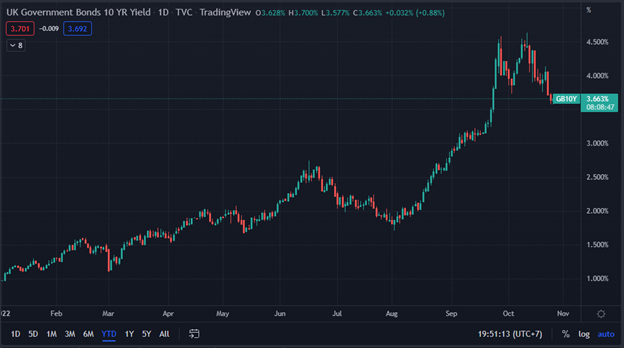
Source: TradingView, as of 26 October 2022
In the US, where midterm election is set for 8 November 2022, all 435 seats in the House of Representatives and 35 of the 100 seats in the Senate will be contested. Newspapers have been pointing to difficulty for the Democrats as Bidenomics proves to be a tough sell on campaign trail. Based on most measures of the labor market, Mr. Biden should not have any trouble making the case for his economic agenda. Under the Democrats’ watch since January 2021, the economic recovery generated 10 million jobs and the unemployment rate shot down to 3.5%. But months of unrelentingly high inflation – with consumer prices still rising at 8.2% in September – have made Bidenomics, which has involved sweeping increases in public spending along with higher tax burdens and stricter enforcement for the wealthy and large companies, an almost impossible sell on the campaign trail. According to a RealClearPolitics polling average, 57.9% of Americans disapprove of Mr. Biden’s handling of the economy, while just 38.9% approve, a critical weakness that has left Democrats with a strong chance of losing control of the House of Representatives and possibly the Senate. Polling analysts at FiveThirtyEight are also saying that the House of Representatives is decisively swinging for Republicans. Losing control of one of both houses of Congress will profoundly shape the next two years of Mr. Biden’s presidency, with Republicans expected to block legislation on family leave, abortion, policing and other Biden priorities while pushing new laws to curb immigration and spending, using the debt ceiling as leverage against the Administration. Republicans are also expected to launch investigations into Democratic spending.
All these political developments are pointing towards an uncertain year in 2023, on top of an uncertain outlook on the main central bank such as the Federal Reserve, on when they might decide to stop their interest rate hike cycle. Because of the uncertainty on the so-called “terminal rate” or the rate at which the Fed is stop hiking, US 10-year government bond yield has shot up to an intraday high at 4.3% on 21 October 2022. Recently, it looked like top Wall Street analysts have been revising up their estimates past the 5% threshold on the terminal rate, alluding to their disbelief in the FOMC members’ forecast of the 4.6% terminal rate. This will certainly be the case if FOMC decides to hike by 75 basis points at both the November and December FOMC meetings, which will put the range of Fed funds rate at 4.5% to 4.75% by the end of this year. Additional two more 25bp hikes next year will then put the Fed funds range at 5.00% to 5.25%, which shows that the FOMC forecast back in September was indeed too low given the current outlook. We shall see how this changes during the next FOMC forecast update in December. In the meantime, we are starting to see equity markets rebounding, in a move that points toward the decline from mid-August to mid-October being too excessive. We had discussed this possibility of a market rebound back in our previous CIO Monthly in September, which is now developing along with our expectations. However, the rebound might not last past the December FOMC, which means that investors should still remain extremely cautious and not add on too much equity exposures, but use the current rebound to trim down some risk exposures in order to reassess the outlook again at the end of the year.
Chart: US 10-year Government Bond Yield in the YTD
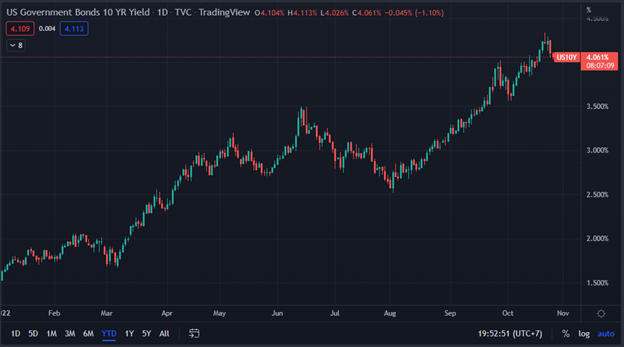
Source: TradingView, as of 26 October 2022
Recommended Funds:
- Principal Asia Pacific Dynamic Income Equity Fund (PRINCIPAL APDI
- Principal China Equity Fund (PRINCIPAL CHEQ)
- Principal Global Brands Fund (PRINCIPAL GBRAND)
- Principal Global Equity ESG Fund (PRINCIPAL GESG)
- Principal Global Infrastructure Equity Fund (PRINCIPAL GIF)
- Principal US Equity Fund (PRINCIPAL USEQ)
Source:
- Mitchell, Tom, et al. “Xi Jinping consolidates power with leadership shake-up at party congress.” The Financial Times, 23 October 2022, www.ft.com/content/fa7b9d68-7c73-4287-8ca7-78c8ddc8dc72. Accessed 26 October 2022.
- Zhai, Keith, and Stella Yifan Xie. “China’s New Slate of Top Leaders Stirs Concern Over Economy.” The Wall Street Journal, 23 October 2022, www.wsj.com/articles/chinas-new-slate-of-top-leaders-stirs-concern-over…. Accessed 26 October 2022.
- Zhai, Keith, and Chun Han Wong. “China’s Xi Claims Third Term as Communist Party Leader.” The Wall Street Journal, 23 October 2022, www.wsj.com/articles/chinas-xi-claims-third-term-as-communist-party-lea…. Accessed 26 October 2022.
- Colchester, Max. “Liz Truss Resigns as U.K. Prime Minister After Tax Plan Caused Market Turmoil.” The Wall Street Journal, 20 October 2022, www.wsj.com/articles/liz-truss-resigns-as-u-k-prime-minister-1166626948…. Accessed 26 October 2022.
- Colchester, Max, and Paul Hannon. “Rishi Sunak Wins Vote to Become U.K.’s Next Prime Minister After Liz Truss Resigns.” The Wall Street Journal, 24 October 2022, www.wsj.com/articles/rishi-sunak-extends-lead-in-race-for-next-u-k-prim…. Accessed 26 October 2022.
- Parker, George, and Delphine Strauss. “Rishi Sunak reappoints Jeremy Hunt as chancellor.” The Financial Times, 26 October 2022, www.ft.com/content/b2aac231-091a-4953-8843-cf84c38c1260. Accessed 26 October 2022.
- Politi, James, and Lauren Fedor. “’Inflation is an acid’: Bidenomics proves tough sell on campaign trail.” The Financial Times, 25 October 2022, www.ft.com/content/0e2b2571-c9ef-4850-8828-9b053aacbc7e. Accessed 26 October 2022.
- Hunnicutt, Trevor, et al. “Midterm elections outlook darkens for Biden’s White House.” Reuters, 26 October 2022, www.reuters.com/world/us/midterm-elections-outlook-darkens-bidens-white…. Accessed 26 October 2022.
- Wong, Chun Han, and Keith Zhai. “China’s Leaders: Xi Jinping and His Men.” The Wall Street Journal, 23 October 2022, www.wsj.com/articles/chinas-leaders-xi-jinping-and-his-men-11666538145?…. Accessed 27 October 2022.
- “Central Committee of the Chinese Communist Party.” Wikipedia, The Free Encyclopedia, Wikimedia Foundation, Inc., 23 October 2022, en.wikipedia.org/wiki/Central_Committee_of_the_Chinese_Communist_Party. Accessed 27 October 2022.
- “Politburo of the Chinese Communist Party.” Wikipedia, The Free Encyclopedia, Wikimedia Foundation, Inc., 25 October 2022, en.wikipedia.org/wiki/Politburo_of_the_Chinese_Communist_Party. Accessed 27 October 2022.
- “Politburo Standing Committee of the Chinese Communist Party.” Wikipedia, The Free Encyclopedia, Wikimedia Foundation, Inc., 24 October 2022, en.wikipedia.org/wiki/Politburo_Standing_Committee_of_the_Chinese_Communist_Party. Accessed 27 October 2022.
Read CIO’s View: October 2022 - Global political activity is heating up


